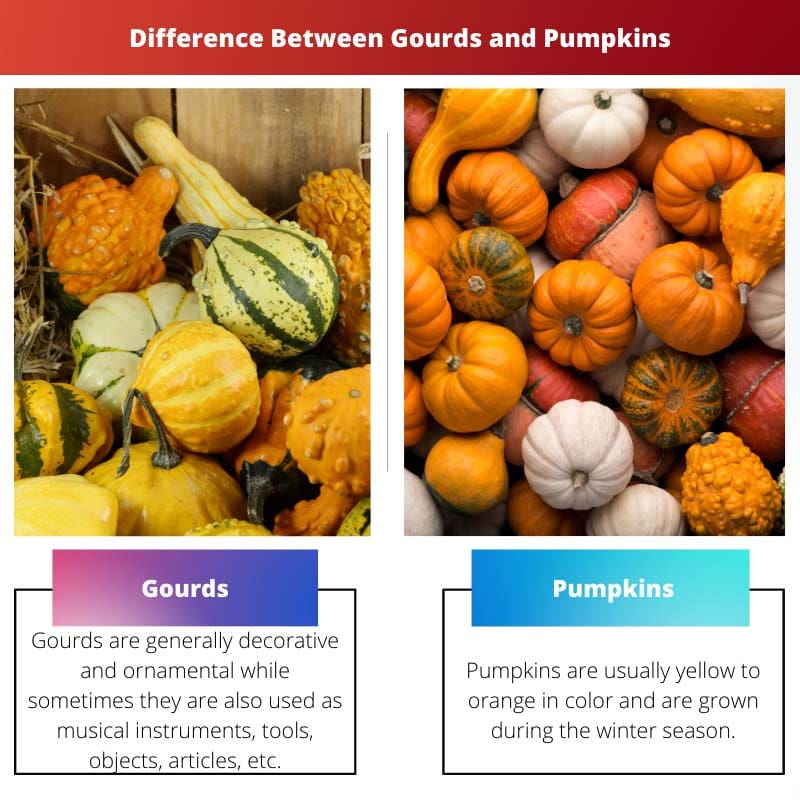One such vegetable confusion is the gourd and pumpkin perplexity. Although they belong to the same family- Cucurbitaceae and are considered as brothers, they differ a lot fundamentally.
Key Takeaways
- Gourds are hard-shelled, inedible plants from the Cucurbitaceae family, while pumpkins are large, edible fruits from the same family.
- Pumpkins are round and orange, whereas gourds come in various shapes, sizes, and colors.
- Gourds are used for decorative purposes and crafting, while pumpkins serve culinary and decorative purposes, especially during Halloween.
Gourds vs Pumpkins
The difference between gourds and pumpkins is that gourds contemplate of several sub-categories, including squashes, melons, etc., and is considered as ornamental fruit whereas pumpkins are considered as ornamental as well as edible. Often pumpkins are also incorporated into gourds, but they carry their own differences and are unique in themselves.

Gourds are decorative and ornamental, while sometimes they are also used as musical instruments, tools, objects, articles, etc. Miniature pumpkins are also included in the gourd sub-category.
Pumpkins are yellow to orange in color and are grown during the winter season. They are hard-shelled, and contain pulp, and are mostly edible. Pumpkins carry a strong flavour.
Comparison Table
| Parameters of Comparison | Gourds | Pumpkins |
|---|---|---|
| Origin | South Africa | North America |
| Shell-Type | Mostly Hard Shell (Dried out) | Mostly Thick Shell (With seeds and pulp) |
| Period of Discovery | 13000 BCE | 7000 to 5500 BCE |
| Edible | Mostly not | Yes |
| Nature of the Stem | Weak and Fragile | Rigid and Stiff |
| Shape | Varying- Long, Cylindrical, Curved, etc. | Mostly Round (Like Snowflakes) |
What are Gourds?
As mentioned above, gourds belong to the family and genus of Cucurbitaceae, particularly Cucurbita and Lagenaria. Cucurbita originates from North America.
But now gourds are omnipresent, every culture uses gourds in one or the other form as they have enormous uses, some use them as musical instruments, some as drums, decorative articles, and tools, while some use them as ornaments.
Gourds are majorly used as containers and vessels at home. Gourds are not edible, excluding some immature gourds which are eaten like other melons and squashes.
So as a solution to this problem, scientists in India are trying to create a hybrid by crossbreeding several breeds of gourds so as to reduce their unappetizing taste and also enhance their nutritional benefit.
Nowadays, dried gourds are used extensively to make kitchen tools like cups, vessels, ladles, bottles, scoops and birdhouses. Thus, every segment of the gourd is useful in a technical and mechanical way, and they make good ornamental/ ornate fruit.

What are Pumpkins?
Although included in the same family as gourds, Pumpkins are considered a sub-category of gourds, squashes, and fruits. Pumpkin literally translates to large melon or winter squash.
It is grown in the winter season and is quite popular during the Halloween and Thanksgiving periods. Pumpkins are edible when ripe and can be baked, steamed, cooked, and are used as a filling in the Thanksgiving pie.
Pumpkins are also included in various diets as they are low in calories and help in weight loss. Pumpkins also bear enormous amounts of omega content that strengthen our immunity.
Pumpkin derived its color from the carotenoid pigments, thus providing vitamin A when consumed. China is the largest pumpkin producer to date, but pumpkins are majorly consumed in The United States.
Almost every fragment of the pumpkin is useful in one way or another. The category and types of pumpkins are vast, including jack-o’-lanterns, Big Max, Prizewinner Pumpkin, and so on.

Main Differences Between Gourds and Pumpkins
- Pumpkins are considered to be older in discovery than gourds.
- Gourds are popular worldwide, while pumpkins are majorly popular in the United States.

- https://pharmacologyonline.silae.it/files/newsletter/2009/vol1/028.Aman.pdf
- https://www.taylorfrancis.com/chapters/edit/10.1201/9781482269871-12/pumpkins-squashes-gourds-desai-musmade

This information is invaluable! The level of detail in the comparison table is helpful in understanding the differences between gourds and pumpkins. It’s nice to learn about the historical and cultural significance of these plants too.
The effort to create a hybrid to make gourds more appetizing is certainly interesting. Altering the taste and enhancing the nutritional benefit of gourds could lead to a shift in their global consumption.
The article provides a wealth of information about gourds and pumpkins. It’s compelling to discover the diverse cultural uses of gourds, and how they’ve become an integral part of different societies.
The practical uses of gourds, such as making kitchen tools and birdhouses, are quite surprising. They are truly versatile fruits, even if they’re not edible. The idea of crossbreeding for taste improvement seems like a major departure from traditional uses.
It is fascinating how pumpkins and gourds have such different uses despite being related. Pumpkins being edible has an important role in North American cuisine, especially during the winter months.
While both gourds and pumpkins are unique in their own right, attempting to crossbreed them seems unnecessary. Preserving the authenticity of these distinct plants should be a priority.